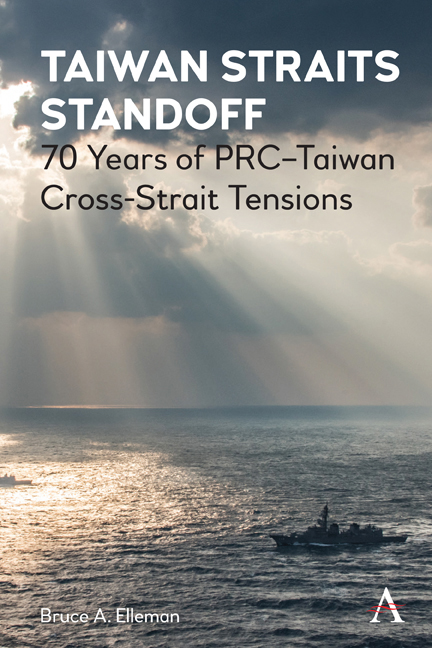Book contents
- Frontmatter
- Dedication
- Contents
- List of Illustrations
- Introduction: Stalemate along the Taiwan Straits, 1949–2020
- 1 The Two Chinas and the Battle for Control of Offshore Islands
- 2 President Harry S. Truman’s Decision to Protect Taiwan
- 3 The First Taiwan Strait Crisis, 1954–55
- 4 The Evacuation of the Dachen Islands, 1955
- 5 The Second Taiwan Strait Crisis, 1958
- 6 The US Threat to Use Atomic Weapons
- 7 Using Taiwan to Undermine the Sino-Soviet Alliance
- 8 Taiwan during the Cold War and Afterward
- Conclusions: The Taiwan Strait’s Strategic Significance Today
- Appendix: Naval Terms and Acronym List
- Selected Bibliography
- Index
5 - The Second Taiwan Strait Crisis, 1958
- Frontmatter
- Dedication
- Contents
- List of Illustrations
- Introduction: Stalemate along the Taiwan Straits, 1949–2020
- 1 The Two Chinas and the Battle for Control of Offshore Islands
- 2 President Harry S. Truman’s Decision to Protect Taiwan
- 3 The First Taiwan Strait Crisis, 1954–55
- 4 The Evacuation of the Dachen Islands, 1955
- 5 The Second Taiwan Strait Crisis, 1958
- 6 The US Threat to Use Atomic Weapons
- 7 Using Taiwan to Undermine the Sino-Soviet Alliance
- 8 Taiwan during the Cold War and Afterward
- Conclusions: The Taiwan Strait’s Strategic Significance Today
- Appendix: Naval Terms and Acronym List
- Selected Bibliography
- Index
Summary
Tensions between the PRC and Taiwan remained high after the first Taiwan Strait crisis in 1954–55. The Nationalist blockade of the PRC continued, albeit at a reduced level, after the Dachens were evacuated. The blockade halted a lower percentage of international shipping with the PRC, since its range was more strictly limited to southeast China. However, the combined effects of the blockade plus the US-sponsored strategic embargo, which lasted until 1971, had a significant impact. To make up for the loss of international seaborne commerce, the PRC was forced to turn to the Soviet Union, conducting an ever larger share of trade via the trans-Siberian railway.
During the late 1950s, the PRC sought to break away from its overreliance on the USSR. China's debts to the USSR were equal to well over a billion US dollars, with one estimate of China's total debt equaling $1.5 billion rubles (almost $2 billion in 1962 dollars). In 1957, there was increasing opposition by the British, Japanese, Germans, Canadians, and French to the Chinese sanctions. In early May 1957, the British argued that the “China differential should be completely abolished.” Dulles wrote to Foreign Minister Selwyn Lloyd, offering to try to meet Britain halfway, but that: “In our opinion, this differential has a real significance in retarding the buildup of Communist China's vast military potential.”
A similar message from Eisenhower to Prime Minister Macmillan warned “that many of the items which you would take off the China list will in fact appreciably help the Chinese Communists to build up the military potential which threatens us in this area and which we have the primary responsibility to resist.” Occurring as it did in the midst of the Nationalist retightening of the blockade, the second Taiwan Strait crisis during 1958 was linked to the PRC goal of halting the blockade once and for all, and thereby diversify its international trade away from the USSR. To try to catch up with the West, Mao Zedong even adopted unsound economic policies like the 1958 “Great Leap Forward,” which eventually produced a nationwide famine that killed millions of average Chinese. Beijing's renewed attacks during 1958 on Jinmen—the Nationalists’ main blockade base—put extreme pressure on Taiwan.
- Type
- Chapter
- Information
- Taiwan Straits Standoff70 Years of PRC–Taiwan Cross-Strait Tensions, pp. 87 - 108Publisher: Anthem PressFirst published in: 2021



